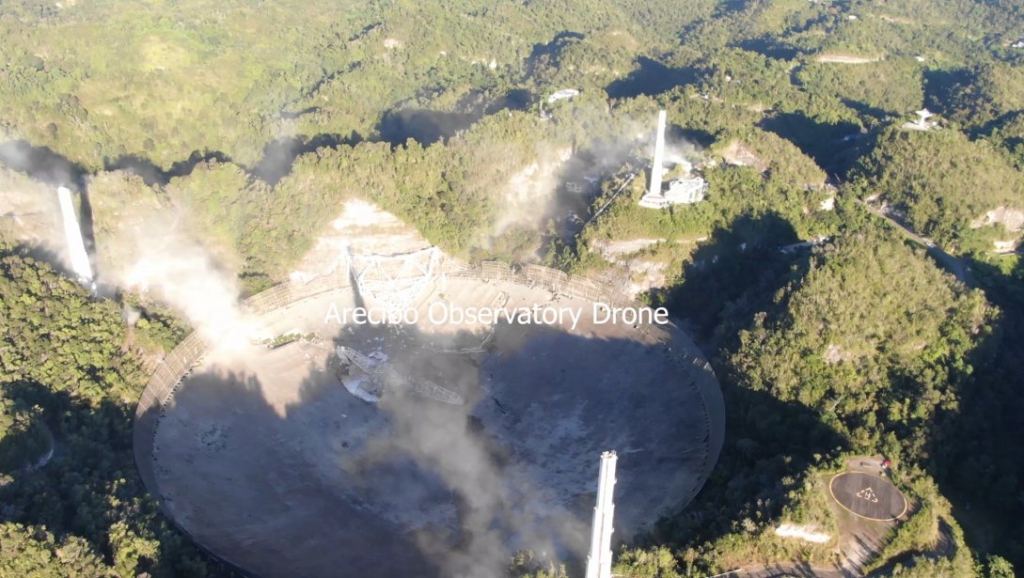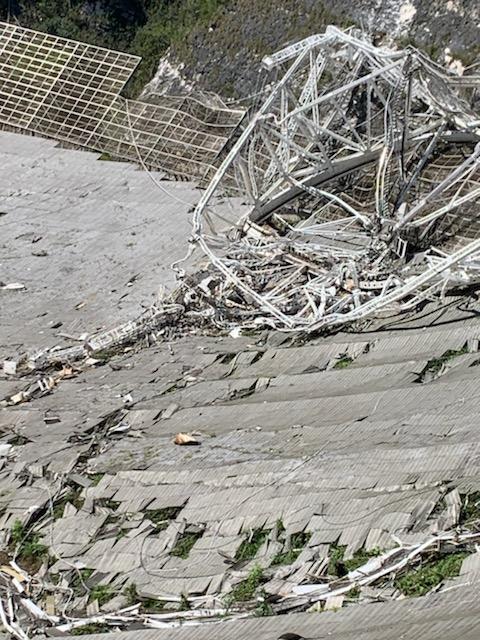The National Science Foundation released two different videos today showing the collapse of the Arecibo Observatory, as it happened on December 1, 2020. Needless to say, the footage is heartbreaking.
In a press briefing on December 3, representatives from the NSF described the two videos. One was taken from a stationary location in the observatory control room, and the other video was taken by a drone that was flying over the observatory to inspect cables and towers.
The first video, below, is taken from the Arecibo Observatory control room, located just north of the dish, in a designated “safe zone.” Officials said the camera was recently placed there to monitor the remaining cables that were still intact following breakage in August and November. The footage from the control room was taken by Carlos Perez, with a GoPro.
As the video begins, visible is a tower in the distance, Tower 4. You can see cables attached to the instrument platform and a catwalk, which is attached to another nearby tower, Tower 12. As cables begin to fail and break, the platform swings instead of falling straight down. As a domino effect, the catwalk cables are severed and break apart, and from the tension and swaying, the tops of the towers break off. The towers are made of reinforced concrete, and the top 62 feet of Tower 4 falls backwards, while the top of Tower 12 tumbles down the hillside and onto the dish.
The second video was captured by Adrian Bague using an aerial drone, and he was in the process of inspecting the cables and towers when the collapse occurred. At the start of this video, you can see three parallel cables, which are the main cables that extend to the instrument platform. You can also see some frayed wires, which are from the cable that failed on November 6.
According to John Abruzzo, who is the managing principal of Thornton Tomasetti, an engineering firm brought in to assess the observatory following the cable failures starting in August, the cables are made of 170 individual wires.
“With the drone footage, we were just lucky to capture it, as engineers were doing ongoing monitoring,” Ashley Zauderer, program director for Arecibo Observatory for the NSF, told reporters. She added that drone operator Adrian Bague is very adept and was able to move the drone around to capture the entirety of what was taking place. “We had been seeing more wire breaks, so that was a request to have additional monitoring,” she said.
In the last few frames in drone video, you can see that damage occurred from falling towers and debris well behind and farther north of Tower 12, which, according to Ralph Gaume, also from the NSF, would have been exactly where crews would have been working if a potential repair plan would have gone forward.

This plan would have involved helicopters hovering over the observatory, with workers hanging down from the helicopters to conduct repairs.
The NSF said the nearby visitor’s center did not sustain any serious damage and now the priority continues to be safety. Engineers are still assessing ways to safely remove debris.
Although many scientists and astronomers are hoping to rebuild a telescope with Arecibo’s capabilities for high resolution radar observations of near-Earth asteroids and other scientific needs, it is too soon for any talk of potential repairs or rebuilding, the officials said.
“Our priorities remain to be safety for all involved, as well as as environmental issues and supporting the scientific community, the Arecibo Observatory staff and the people of Puerto Rico,” said Zauderer.
You can see the original footage and information from the NSF here.

